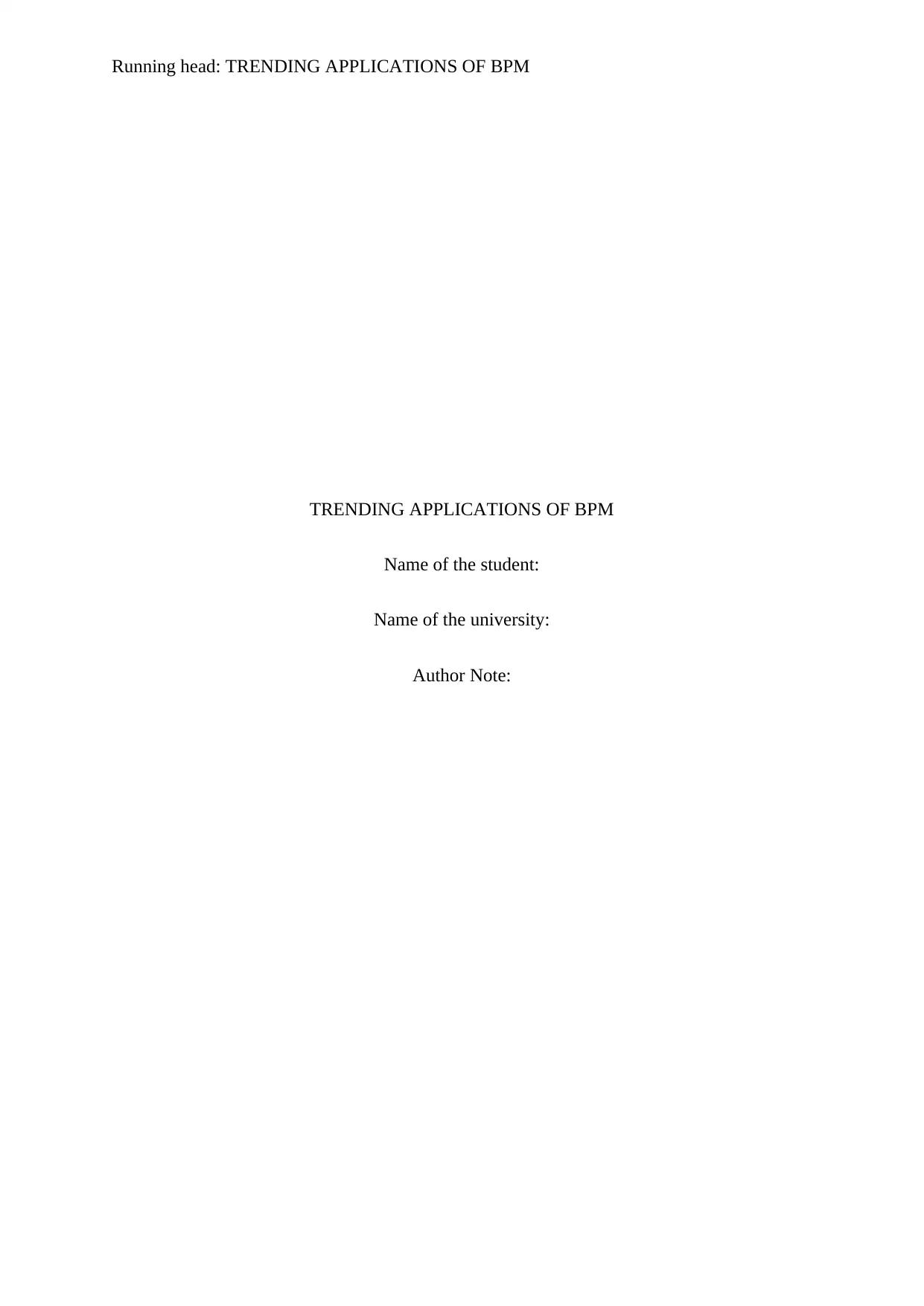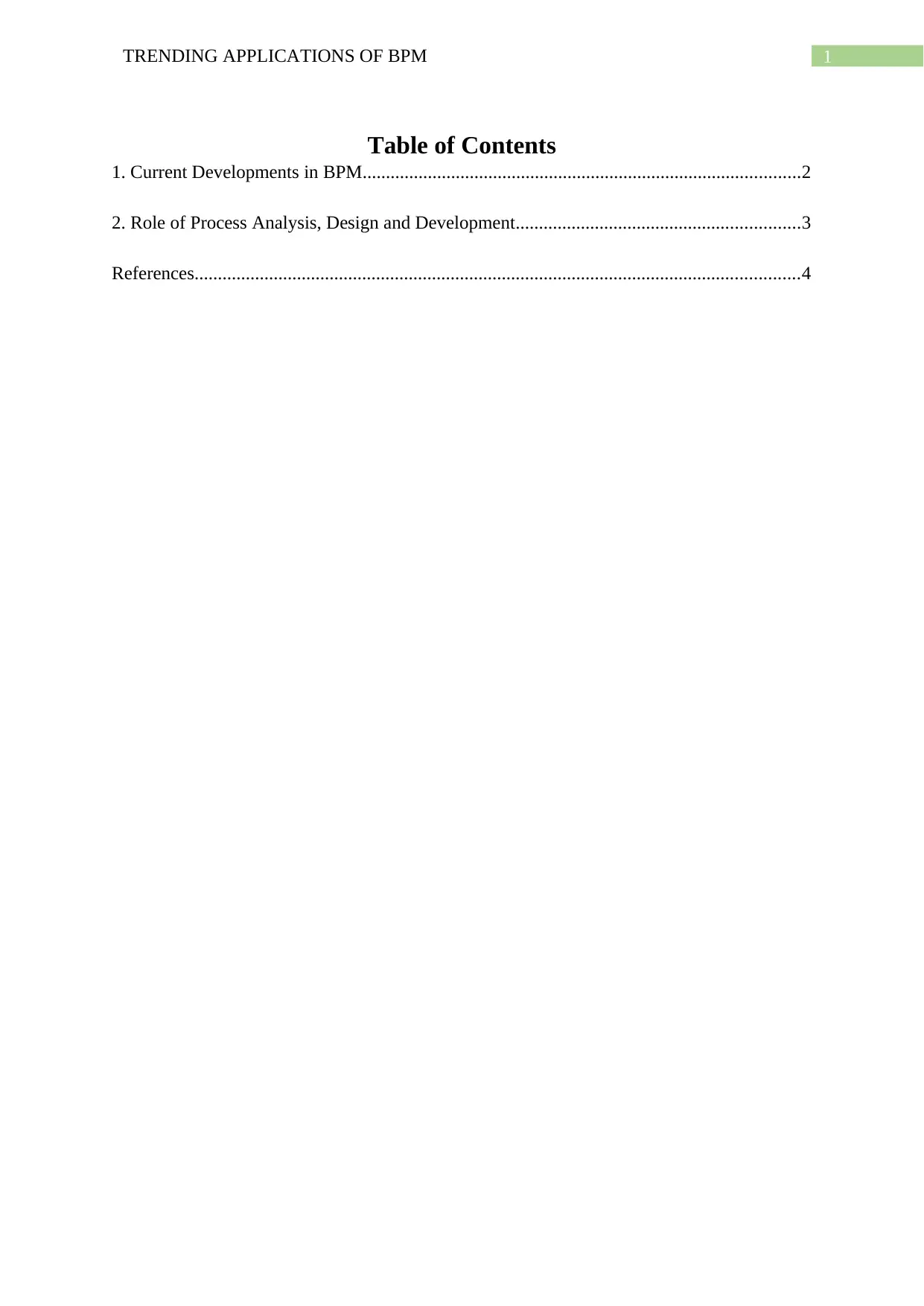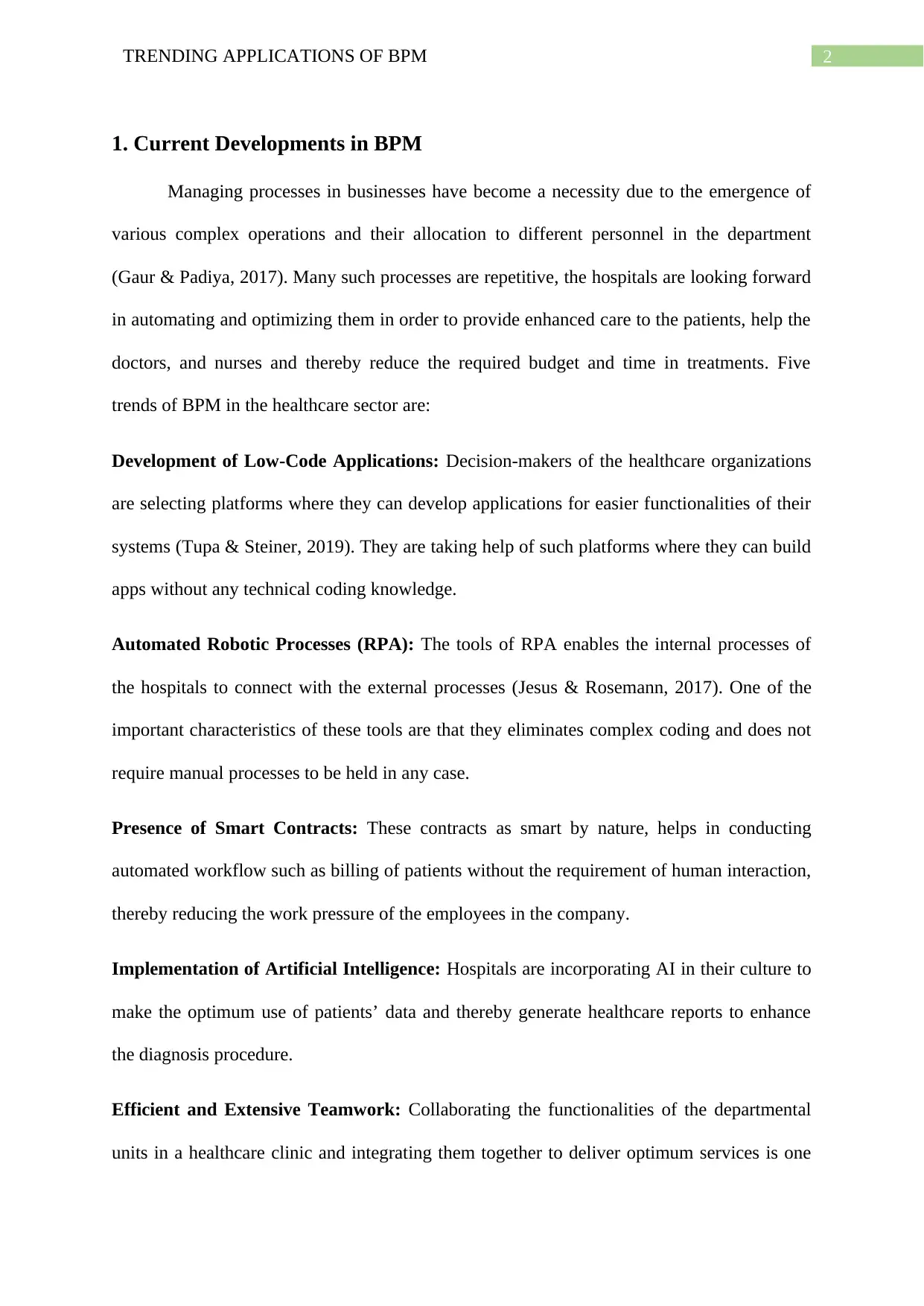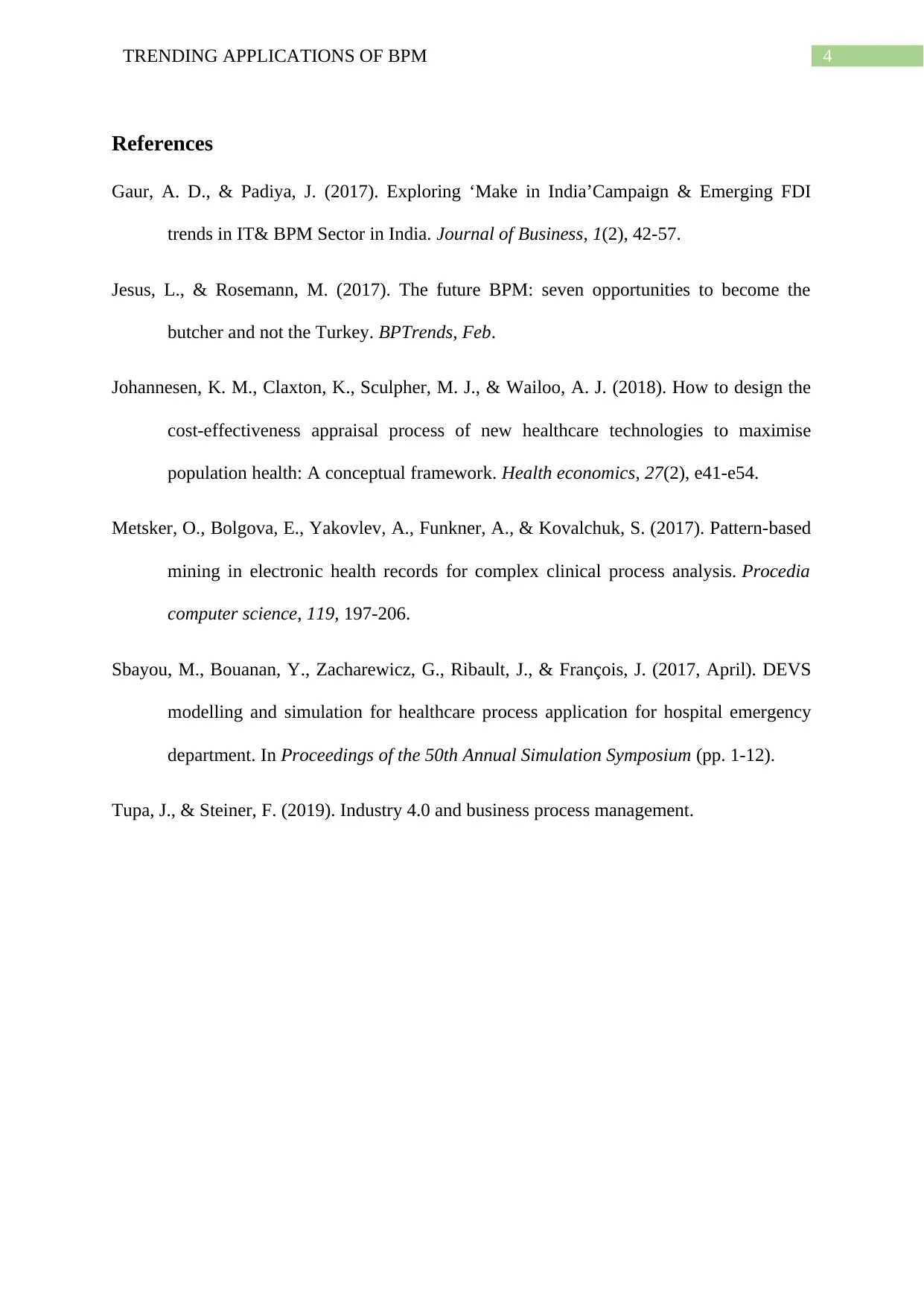Business Process Management in Healthcare: A Trends Report
VerifiedAdded on 2022/09/26
|5
|903
|21
Report
AI Summary
This report provides an overview of the trending applications of Business Process Management (BPM) in the healthcare sector, emphasizing the importance of process analysis, design, and development. It highlights five key BPM trends: the development of low-code applications, Robotic Process Automation (RPA), the use of smart contracts, the implementation of Artificial Intelligence (AI), and efficient teamwork. The report underscores the critical role of process analysis in identifying shortcomings and improving healthcare services, including the use of process mining and the development of information systems. Furthermore, the report discusses the significance of these trends in the context of the Joondalup Hospital case study, addressing current business processes and their potential issues. The analysis indicates the need for automation to optimize processes, enhance patient care, and streamline hospital operations.

Running head: TRENDING APPLICATIONS OF BPM
TRENDING APPLICATIONS OF BPM
Name of the student:
Name of the university:
Author Note:
TRENDING APPLICATIONS OF BPM
Name of the student:
Name of the university:
Author Note:
Paraphrase This Document
Need a fresh take? Get an instant paraphrase of this document with our AI Paraphraser

1TRENDING APPLICATIONS OF BPM
Table of Contents
1. Current Developments in BPM..............................................................................................2
2. Role of Process Analysis, Design and Development.............................................................3
References..................................................................................................................................4
Table of Contents
1. Current Developments in BPM..............................................................................................2
2. Role of Process Analysis, Design and Development.............................................................3
References..................................................................................................................................4

2TRENDING APPLICATIONS OF BPM
1. Current Developments in BPM
Managing processes in businesses have become a necessity due to the emergence of
various complex operations and their allocation to different personnel in the department
(Gaur & Padiya, 2017). Many such processes are repetitive, the hospitals are looking forward
in automating and optimizing them in order to provide enhanced care to the patients, help the
doctors, and nurses and thereby reduce the required budget and time in treatments. Five
trends of BPM in the healthcare sector are:
Development of Low-Code Applications: Decision-makers of the healthcare organizations
are selecting platforms where they can develop applications for easier functionalities of their
systems (Tupa & Steiner, 2019). They are taking help of such platforms where they can build
apps without any technical coding knowledge.
Automated Robotic Processes (RPA): The tools of RPA enables the internal processes of
the hospitals to connect with the external processes (Jesus & Rosemann, 2017). One of the
important characteristics of these tools are that they eliminates complex coding and does not
require manual processes to be held in any case.
Presence of Smart Contracts: These contracts as smart by nature, helps in conducting
automated workflow such as billing of patients without the requirement of human interaction,
thereby reducing the work pressure of the employees in the company.
Implementation of Artificial Intelligence: Hospitals are incorporating AI in their culture to
make the optimum use of patients’ data and thereby generate healthcare reports to enhance
the diagnosis procedure.
Efficient and Extensive Teamwork: Collaborating the functionalities of the departmental
units in a healthcare clinic and integrating them together to deliver optimum services is one
1. Current Developments in BPM
Managing processes in businesses have become a necessity due to the emergence of
various complex operations and their allocation to different personnel in the department
(Gaur & Padiya, 2017). Many such processes are repetitive, the hospitals are looking forward
in automating and optimizing them in order to provide enhanced care to the patients, help the
doctors, and nurses and thereby reduce the required budget and time in treatments. Five
trends of BPM in the healthcare sector are:
Development of Low-Code Applications: Decision-makers of the healthcare organizations
are selecting platforms where they can develop applications for easier functionalities of their
systems (Tupa & Steiner, 2019). They are taking help of such platforms where they can build
apps without any technical coding knowledge.
Automated Robotic Processes (RPA): The tools of RPA enables the internal processes of
the hospitals to connect with the external processes (Jesus & Rosemann, 2017). One of the
important characteristics of these tools are that they eliminates complex coding and does not
require manual processes to be held in any case.
Presence of Smart Contracts: These contracts as smart by nature, helps in conducting
automated workflow such as billing of patients without the requirement of human interaction,
thereby reducing the work pressure of the employees in the company.
Implementation of Artificial Intelligence: Hospitals are incorporating AI in their culture to
make the optimum use of patients’ data and thereby generate healthcare reports to enhance
the diagnosis procedure.
Efficient and Extensive Teamwork: Collaborating the functionalities of the departmental
units in a healthcare clinic and integrating them together to deliver optimum services is one
⊘ This is a preview!⊘
Do you want full access?
Subscribe today to unlock all pages.

Trusted by 1+ million students worldwide

3TRENDING APPLICATIONS OF BPM
of the effective trends of BPM that contributes to enhanced treatments of patients by the
doctors.
2. Role of Process Analysis, Design and Development
The allowance of efficient healthcare services to the patients in the hospitals and
nursing units depends highly on flexible and efficient process execution in their daily
activities. The healthcare units can improve their processes only to contribute to their easy
work functionality as well as provide quality services to the sick people (Sbayou et al., 2017).
Hence, process analysis is an integral part of their business that reviews the functionality of
the processes, detects the shortcomings in the outcome and finally adapt methodologies that
will help in filling the unnecessary gaps in their techniques.
Process mining is one important components of process analysis, a technique by
which data is extracted from the processes to generate reports that will help in making
effective decisions for the healthcare systems (Metsker et al., 2017). The Information
Systems in healthcare are designed based on these data collected from the process analysis
that eases out the operations in healthcare and automates them to speed up the process. This
finally helps in better and faster diagnosis of patients contributing to the betterment of the
health of the patients.
Development of Information Systems in the healthcare organizations not only
facilitates the patients in various aspects, it also optimises the activities in the hospitals and
nursing homes (Johannesen et al., 2018). Numerous processes such as data entry of patients
or generating healthcare report become automated helping the doctors detect more than one
patient at a time. Upgraded information through such systems also helps in combatting
emergency of the patients.
of the effective trends of BPM that contributes to enhanced treatments of patients by the
doctors.
2. Role of Process Analysis, Design and Development
The allowance of efficient healthcare services to the patients in the hospitals and
nursing units depends highly on flexible and efficient process execution in their daily
activities. The healthcare units can improve their processes only to contribute to their easy
work functionality as well as provide quality services to the sick people (Sbayou et al., 2017).
Hence, process analysis is an integral part of their business that reviews the functionality of
the processes, detects the shortcomings in the outcome and finally adapt methodologies that
will help in filling the unnecessary gaps in their techniques.
Process mining is one important components of process analysis, a technique by
which data is extracted from the processes to generate reports that will help in making
effective decisions for the healthcare systems (Metsker et al., 2017). The Information
Systems in healthcare are designed based on these data collected from the process analysis
that eases out the operations in healthcare and automates them to speed up the process. This
finally helps in better and faster diagnosis of patients contributing to the betterment of the
health of the patients.
Development of Information Systems in the healthcare organizations not only
facilitates the patients in various aspects, it also optimises the activities in the hospitals and
nursing homes (Johannesen et al., 2018). Numerous processes such as data entry of patients
or generating healthcare report become automated helping the doctors detect more than one
patient at a time. Upgraded information through such systems also helps in combatting
emergency of the patients.
Paraphrase This Document
Need a fresh take? Get an instant paraphrase of this document with our AI Paraphraser

4TRENDING APPLICATIONS OF BPM
References
Gaur, A. D., & Padiya, J. (2017). Exploring ‘Make in India’Campaign & Emerging FDI
trends in IT& BPM Sector in India. Journal of Business, 1(2), 42-57.
Jesus, L., & Rosemann, M. (2017). The future BPM: seven opportunities to become the
butcher and not the Turkey. BPTrends, Feb.
Johannesen, K. M., Claxton, K., Sculpher, M. J., & Wailoo, A. J. (2018). How to design the
cost‐effectiveness appraisal process of new healthcare technologies to maximise
population health: A conceptual framework. Health economics, 27(2), e41-e54.
Metsker, O., Bolgova, E., Yakovlev, A., Funkner, A., & Kovalchuk, S. (2017). Pattern-based
mining in electronic health records for complex clinical process analysis. Procedia
computer science, 119, 197-206.
Sbayou, M., Bouanan, Y., Zacharewicz, G., Ribault, J., & François, J. (2017, April). DEVS
modelling and simulation for healthcare process application for hospital emergency
department. In Proceedings of the 50th Annual Simulation Symposium (pp. 1-12).
Tupa, J., & Steiner, F. (2019). Industry 4.0 and business process management.
References
Gaur, A. D., & Padiya, J. (2017). Exploring ‘Make in India’Campaign & Emerging FDI
trends in IT& BPM Sector in India. Journal of Business, 1(2), 42-57.
Jesus, L., & Rosemann, M. (2017). The future BPM: seven opportunities to become the
butcher and not the Turkey. BPTrends, Feb.
Johannesen, K. M., Claxton, K., Sculpher, M. J., & Wailoo, A. J. (2018). How to design the
cost‐effectiveness appraisal process of new healthcare technologies to maximise
population health: A conceptual framework. Health economics, 27(2), e41-e54.
Metsker, O., Bolgova, E., Yakovlev, A., Funkner, A., & Kovalchuk, S. (2017). Pattern-based
mining in electronic health records for complex clinical process analysis. Procedia
computer science, 119, 197-206.
Sbayou, M., Bouanan, Y., Zacharewicz, G., Ribault, J., & François, J. (2017, April). DEVS
modelling and simulation for healthcare process application for hospital emergency
department. In Proceedings of the 50th Annual Simulation Symposium (pp. 1-12).
Tupa, J., & Steiner, F. (2019). Industry 4.0 and business process management.
1 out of 5
Related Documents
Your All-in-One AI-Powered Toolkit for Academic Success.
+13062052269
info@desklib.com
Available 24*7 on WhatsApp / Email
![[object Object]](/_next/static/media/star-bottom.7253800d.svg)
Unlock your academic potential
Copyright © 2020–2025 A2Z Services. All Rights Reserved. Developed and managed by ZUCOL.





